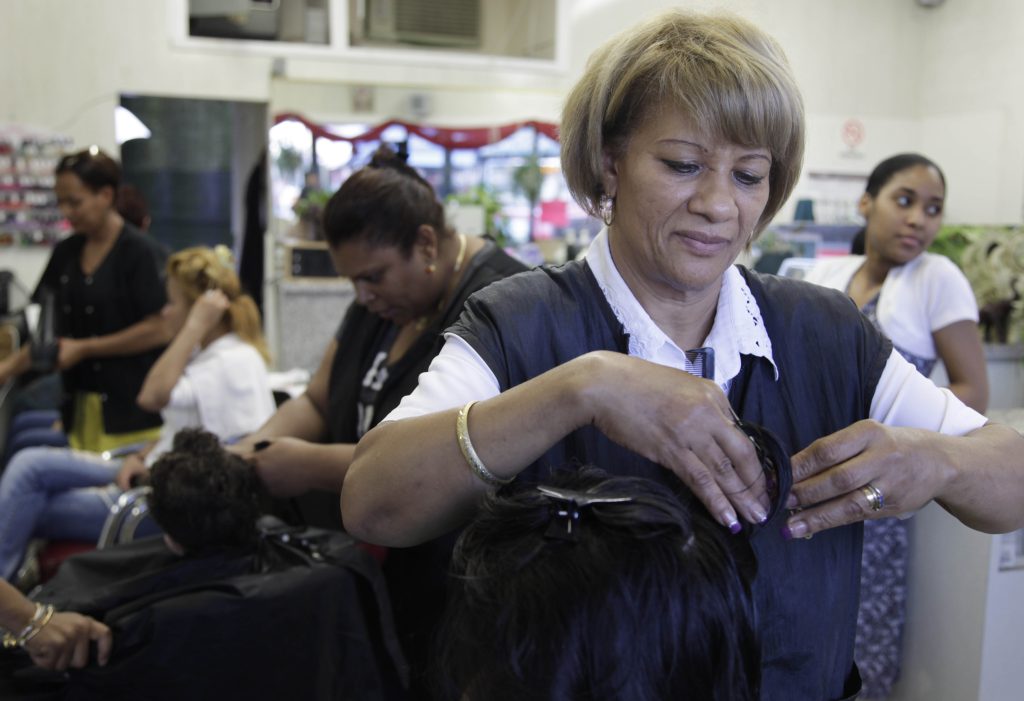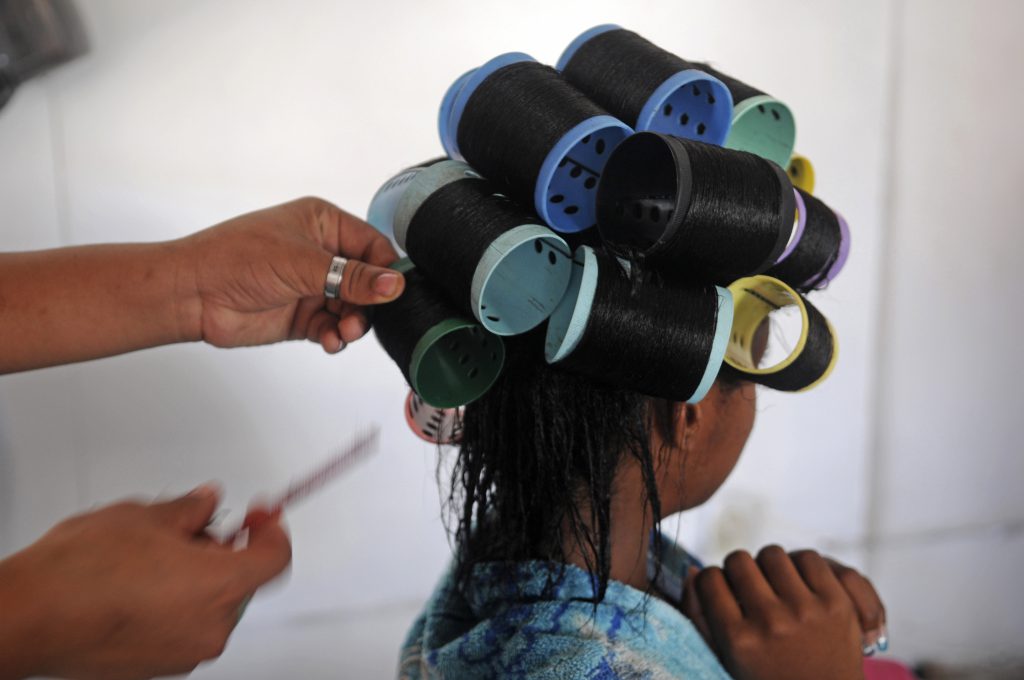Rethinking Beauty and Race at Dominican-American Hair Salons

This article was originally published at The Conversation and has been republished under Creative Commons.
When Chabelly Pacheco—a Dominican-American who moved to Long Island when she was 5 years old—walks into her favorite Dominican salon on Brooklyn’s Graham Avenue, it’s more like entering a home than a business.
The salon is filled with smoke, hair spray, and women of all ages. Everyone in the room greets her: The hairdressers kiss her on both cheeks, while the other customers say hello. Daughters sit alongside their mothers with curlers in their hair, feet dangling from their chairs.
For first-generation Dominican women like Pacheco, these salons can serve as a place to bond with fellow Dominicans.
![]()
“I don’t really feel connected to my culture,” said Yoeli Collado, a friend of Pacheco’s who moved to Long Island from the Dominican Republic when she was 3 years old. “When I speak Spanish, I feel powerful. … But other than that I don’t have much I can connect to. So going to a Dominican salon is part of my culture. For me, it’s one of the only ways I can identify.”
Other diasporas have a wide range of cultural public spaces. There are Chinese community centers and Indian music venues, Russian tea rooms and Ghanaian restaurants.
For Dominicans, the salon plays an outsized cultural role.
Fascinated by these spaces—and as a scholar studying women’s issues—I wanted to see how salons and Dominican beauty regimens influence female Dominican-American identity.
I found that although Dominican-American women I interviewed spoke warmly of the salons they frequent, Dominican hair culture is far from glamorous. In many ways, it’s a pricey, burdensome ritual steeped in colonial beauty standards—a contradiction that young Dominican women are grappling with today.
“The hair carries the woman”
As in many cultures, Dominican female beauty standards can be burdensome. Though most Dominicans tend to have curly, textured hair, the culture favors long, straight hair. Curly, frizzy, or kinky hair is called pelo malo, which translates to “bad hair,” and many women feel pressured to treat it.
“I hear my mom say it all the time,” Pacheco said. “‘The hair carries the woman’—that’s the mantra in my family. If your hair is fine, you’re fine.”
Despite the lively atmosphere of the salon, it’s not all fun. It can be costly, painful, and time-consuming.
Sociologist Ginetta Candelario has found that Dominican women visit salons far more frequently than any other female population in the U.S., spending up to 30 percent of their salaries on beauty regimens.
Many Dominican kids don’t have any say over how to style their hair; their parents force them to get it straightened. This was evident in Pacheco’s salon, where young girls tugged at the tight curlers in their hair, complaining that the dryers were burning their scalps.
“You’re taught from a young age that your hair has to be straight to be pretty, to get a job, to get a boyfriend, to be called pretty by your mother,” Pacheco told me.
It all stems from a strict hair culture in the Dominican Republic, where young women can actually be sent home from school or work if their hair isn’t worn in the “preferred way.” Women with untreated, natural hair can even be barred from some public and private spaces.
Though discrimination against curly hair isn’t as pronounced in New York, many Dominican-American women told me that they nevertheless feel the same sort of pressure.
No such thing as black
The Dominican tradition of straight hair has it roots in colonial rule under Spain; it eventually became a way to imitate the higher classes and to separate themselves from their Haitian neighbors, who once occupied their country and championed the négritude movement, which was started by black writers to defend and celebrate a black cultural identity.
Dominicans believe that Haitians are black, while Dominicans—even those who clearly descend from African heritage—fall into other nonblack categories.
The process of differentiation is referred to as blanqueamiento, which translates to “whitening,” and hair straightening is simply one of many ways Dominicans try to distinguish themselves from Haitians. In fact, even though the Dominican Republic ranks fifth in countries outside of Africa that have the largest black populations, many black Dominicans don’t consider themselves black.
“[Blackness] is a taboo in the DR,” Stephanie Lorenzo, a 25-year-old Dominican-American from the Bronx, explained. “You don’t want to be black.”
According to Yesilernis Peña, a researcher at the Instituto Tecnologico de Santo Domingo who studies race in the Latin Caribbean, there are six established racial categories in the Dominican Republic, and they tend to correlate with one’s economic class: white, mixed race, olive, Indian, dark, and black.
Meanwhile, a light-skinned elite has consolidated most of the political power, while many of the country’s black people—who make up the majority of the population—live in extreme poverty. So straightening one’s hair can be seen as an attempt to climb the social ladder—or at least imitate those with money and power.
“When people relax their hair or bleach it, they do it because they want to be closer to the people who hold the power,” Dominican salon owner Carolina Contreras told the magazine Remezcla in 2015.
“But I like it straight”
Given the fraught history of hair, it’s clear that Dominican salons, with the beauty regimens they perpetuate, are complex, contradictory places.
Pacheco—who grew up in America and loves spending time at the salon—is aware that she’s also tacitly succumbing to beauty norms steeped in racism.
“Obviously it’s a construct, and it puts pressure on women and sometimes I feel conflicted about getting my hair straightened,” she said. “That deeply rooted colonial oppression is still there. But then I’m like, ‘I like it straight.’”
In sociologist Ginetta Candelario’s study “Hair Race-ing: Dominican Beauty Culture and Identity Production,” she wonders if beauty can be a source of empowerment, even if it means using time and resources, while suppressing one’s “blackness.”
Through her extensive research in Dominican salons in New York, Candelario did find that women can, in fact, empower themselves through these beauty norms. By physically altering their appearance, they could get better jobs and use their beauty as “symbolic and economic capital.”
But she points out that in order for this beauty regimen to exist in the first place, it requires “ugliness to reside somewhere, and that somewhere is in other women, usually women defined as black.”
Reimagining beauty, reinventing space
In 2014, Carolina Contreras opened up Miss Rizos, a natural hair salon located in the colonial city center of Santo Domingo, the nation’s capital.
The 29-year-old Dominican-American wanted her salon to champion “pajón love” (Afro love), and to reimagine what a Dominican salon and a Dominican beauty regimen might look like. The salon, which caters to Dominican-Americans, encourages women to wear their Afro-textured hair with pride.
It was at Contreras’s salon where Stephanie Lorenzo decided to do “the big chop” in 2015: She cut off her chemically altered hair, leaving her with a small Afro.
“Around the same time, I was becoming more in touch with my African roots as an American woman,” she said. “[Cutting my hair] was part of acknowledging that we are also black.”
Back in Brooklyn, Chabelly Pacheco’s hairdresser said that during her 30 years working in salons in the Dominican Republic, Haiti, and New York, she’s noticed more women asking for natural hair treatments. In fact, many older Dominican women are now starting to change the way they see their own hair. Carolina Contreras’ mother told me that she decided to go natural to be closer to the way God imagined her.
Contreras, however, is quick to note that the natural hair movement isn’t meant to shame women who do choose to straighten their hair. Instead, it’s simply about making textured hair accepted, appreciated, and celebrated.
Perhaps by embracing all different kinds of hair, salons—which bring Dominican women closer to their culture and to each other—can also bring Dominican women closer to their natural selves.


























